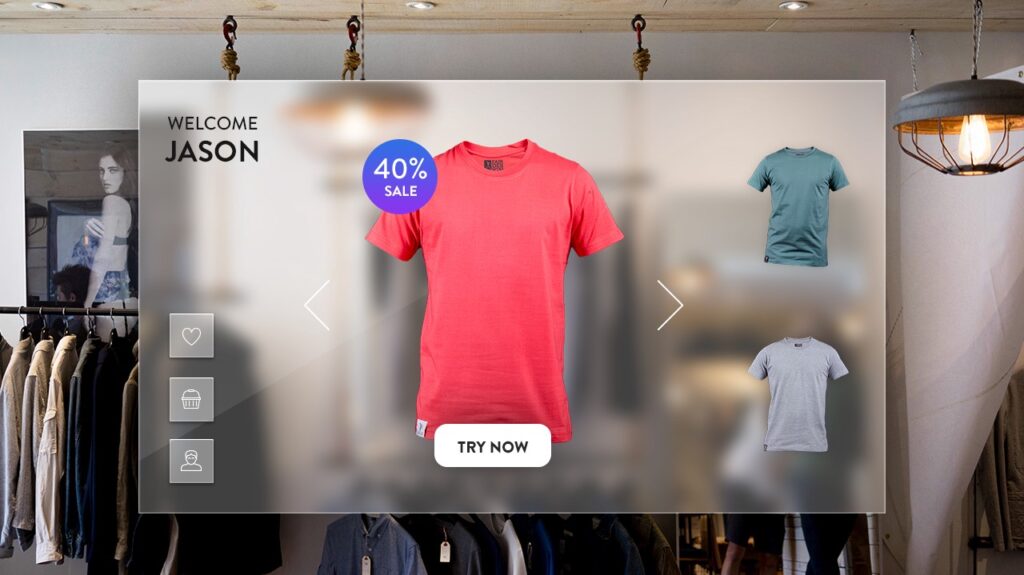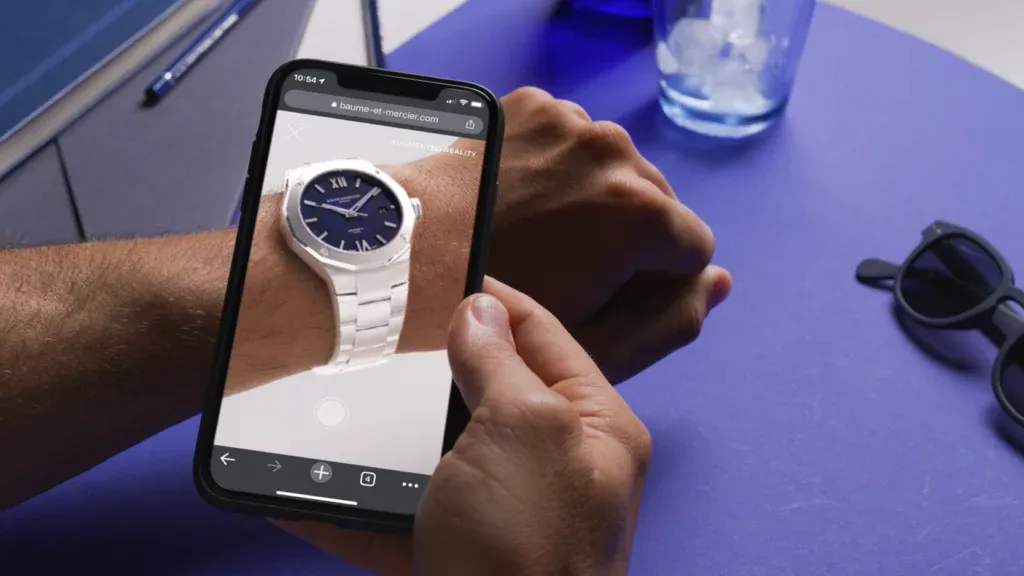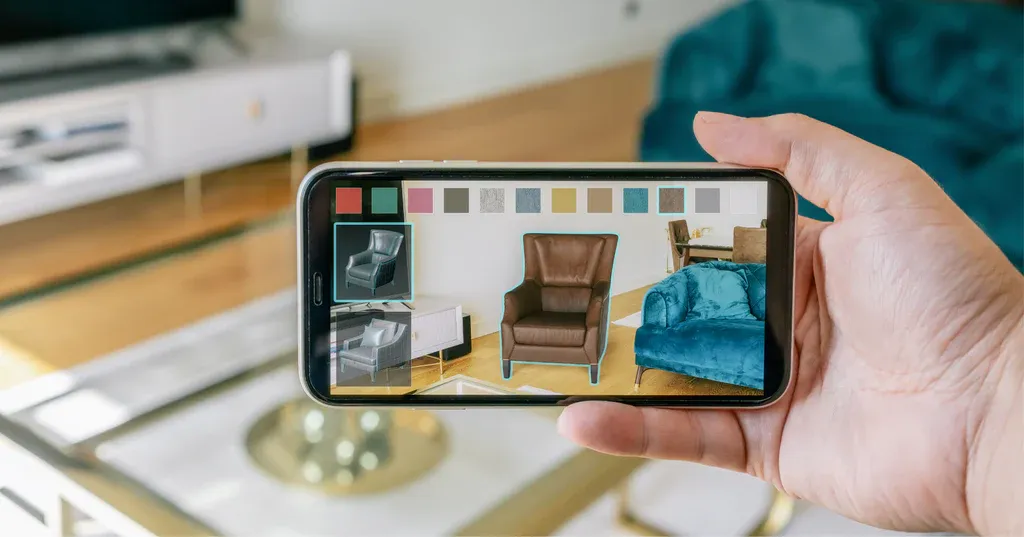Blog

VR in E-Commerce: Potential and Technologies
The Potential of Virtual Reality in E-Commerce
Virtual Shopping with Friends
Retailers can improve the online shopping experience by creating virtual showrooms or using VR in e-commerce. Customers can visit these virtual spaces from their homes, exploring a blend of fantastical and familiar elements while shopping with friends in virtual stores, bringing a social aspect to eCommerce experiences. These online environments will resemble physical stores, allowing consumers to browse products as if they were in a brick-and-mortar location.

Traditional physical stores can attract customers with appealing atmospheres, music, and dynamic displays. With VR, eCommerce brands can recreate these immersive environments, offering a unique online shopping experience, including interactive, shoppable virtual stores and showrooms. Notable examples include eBay’s virtual reality department store, created in partnership with Myer, and luxury home decor brand Jonathan Adler’s virtual showrooms.
The social platform Squadded Shopping Party was created to encourage users to shop online together, and brands like Charlotte Tilbury have integrated group shopping features into their online platforms. By collaborating with companies offering VR technology services, businesses can develop an eCommerce platform that caters to the demand for interactive and social virtual shopping experiences.
AI-Powered Shopping Assistants
AI-powered chatbots, also known as virtual shopping assistants, are becoming a significant trend in eCommerce. These digital assistants offer customer guidance, providing 24/7 support and upselling opportunities at a lower cost than human employees.
VR shopping experience by inVRsion
Initially, virtual shopping assistants could only answer basic questions, but technological advances have made them capable of addressing various customer needs, including providing order information, deals, and recommendations. IBM reports that chatbots can now answer up to 80% of routine questions, and Statista research shows that 34% of online shoppers prefer them over human support agents. As a result, brands like Sephora, H&M, and LEGO have implemented virtual shopping assistants on their online platforms and social media pages.
Try-On Experiences and Fitting Rooms
One advantage of physical stores over online shopping is the ability to try products before purchasing. To address this, eCommerce platforms have begun offering virtual try-on solutions, allowing customers to make informed decisions by testing products virtually.

Baume & Mercier offers their customers a virtual try-on system
Using Augmented Reality (AR) and VR technologies, apps available on the Apple Store and Play Store enable users to try on clothing or accessories virtually. In 2017, Audi used the Oculus Rift headset to let customers customize their dream cars in 3D, providing an interactive visualization of potential upgrades.
Successful VR E-Commerce Examples
– Walmart
The retail giant partnered with Spatialand to create a VR experience that lets customers browse home decor products in a virtual showroom. The experience was built using the Unity engine.
– BMW
The luxury car brand created a VR experience called the BMW i Visualizer that allows customers to configure and visualize their dream car in 3D. The experience was built using the Unreal Engine.
– North Face
The outdoor apparel company created a VR experience that lets customers explore Yosemite National Park and try on clothing in a virtual environment. The experience was built using the A-Frame framework.
– Amazon
The online retailer created an AR shopping feature called Amazon AR View that allows customers to see how products would look in their homes using their smartphone camera. The feature was built using Apple’s ARKit and Google’s ARCore.
– Ray-Ban:
The eyewear brand created a VR experience that lets customers try on glasses in a virtual environment. The experience was built using the Unity engine.
– Houzz:
The home design platform created an AR shopping feature called View in My Room 3D that allows customers to see how furniture and decor would look in their homes using their smartphone camera. The feature was built using Apple’s ARKit and Google’s ARCore.
– Shopify:
The e-commerce platform offers a VR app called Shopify AR that allows customers to see how products would look in their homes using AR. The app was built using the Unity engine.
Implementing E-commerce with VR

Best Development Technologies for VR E-Commerce
Virtual reality (VR) technology is transforming the e-commerce industry by providing customers with immersive and engaging shopping experiences. To create successful VR e-commerce applications, businesses must use the best development technologies available. Several development technologies can be used for creating VR e-commerce experiences, depending on the project’s specific requirements. Here are some of the best development technologies for VR e-commerce:
1. Unity
Unity is a popular game engine that can create highly interactive and immersive experiences, including VR. Unity offers a range of features for creating VR experiences, including support for multiple VR platforms and integrations with popular e-commerce platforms. Additionally, Unity is widely used by developers, making it easy to find support and resources.
2. Unreal Engine
Unreal Engine is another popular game engine that can be used to create VR e-commerce experiences. Unreal Engine provides advanced features for creating highly realistic and detailed environments and models, making it a popular choice for creating VR e-commerce experiences. However, it can have a steeper learning curve compared to Unity.
3. A-Frame
A-Frame is an open-source framework for creating VR experiences using web technologies such as HTML and JavaScript. A-Frame is easy to use and provides a range of pre-built components, making it a flexible option for creating VR e-commerce experiences that can be accessed through web browsers.
4. Flutter
Flutter is a UI toolkit for building natively compiled mobile, web, and desktop applications from a single codebase. It can be used for creating VR e-commerce experiences when combined with Unity or other game engines. Flutter also allows for cross-platform development, making it easier and more cost-effective to develop VR e-commerce applications.
5. WebVR
WebVR is an API that allows for creating VR experiences using web technologies such as HTML, CSS, and JavaScript. It is an open standard supported by various VR devices, making it a flexible option for creating VR e-commerce experiences. WebVR also allows for VR experiences to be accessed through web browsers.
6. Combination of Flutter and Unity
Combining Flutter and Unity allows for cross-platform development, meaning that the same VR e-commerce application can be used for Android, iOS, Windows and Web. This capability makes it easier and more cost-effective to develop VR e-commerce applications and provides a more consistent experience for users across different platforms.
Flutter is already an excellent choice for e-commerce applications, as it has many possibilities and integrations with other services like f.e. Shopify and combining it with flutter creates room for AR/VR features. More about this combination can be found here, and more about Flutter for e-commerce here.
Basic steps
Implementing virtual reality (VR) in e-commerce can be a complex process. To help you get started, follow these steps with the support of an experienced team:

1. Define your objectives.
Determine the specific goals you want to achieve by incorporating VR technology. Examples include gaining press attention, providing customers with a more immersive product experience, or reducing return rates by offering better product information.
2. Decide on the type of experience you want to offer.
Consider whether you want to create an experience-based, product-based, or interactive VR solution that allows users to engage with products, friends, or shopping assistants.
3. Create your VR content.
Consider the level of technology required for your desired experience, whether it’s passive or interactive, and if it supports users exploring a virtual environment. Collaborate with a VR developer who has experience in both design and coding.
4. Integrate VR with e-commerce platforms.
Ensure seamless integration between the VR experience and your e-commerce platform to provide a smooth customer journey and maintain brand consistency. You can achieve this by using APIs provided by e-commerce platforms like Shopify or Magento or by working with specialized VR e-commerce solutions like Obsess or Threekit. Examples of successful VR integrations include eBay’s virtual department store and IKEA’s VR showroom.
5. Develop and test the VR experience.
Focus on the technical functionality and user experience, ensuring all elements work correctly and respond to human interaction. Test for usability, navigation, and interface intuitiveness, and verify that the experience does not cause discomfort or nausea.
6. Promote your VR initiative.
Spread the word about your VR project, but remember that you’re marketing your store, products, and experience – VR is just the tool. Consider how consumers will access the experience and provide VR headsets like eBay and Myer did for their virtual department store if needed.
Conclusion
In conclusion, virtual reality is a game-changer for the e-commerce industry, providing customers with immersive and engaging shopping experiences. From virtual showrooms to try-on experiences and fitting rooms, retailers can offer unique and interactive shopping experiences that were previously only possible in physical stores. The use of AI-powered shopping assistants and the integration of AR and VR technologies have further enhanced the customer experience, providing 24/7 support, upselling opportunities, and the ability to try products before purchasing. Companies like Walmart, BMW, and North Face have successfully implemented VR in e-commerce, showcasing the potential of this technology. To create successful VR e-commerce applications, businesses must use the best development technologies available, such as Unity, Unreal Engine, A-Frame, Flutter, and WebVR. By following the basic steps outlined in this post and collaborating with experienced VR developers, businesses can integrate VR seamlessly into their e-commerce platforms, providing customers with an unforgettable shopping experience.
Get latest insights, ideas and inspiration
Take your app development and management further with Codigee
Let's make something together.
At Codigee, we value transparency, efficiency, and simplicity. No overengineering. No wasted time.
Just straight-up execution.
We are obsessed.
Every billion-dollar company started with one decision, one step, one iteration. The key? Taking action and executing fast.

